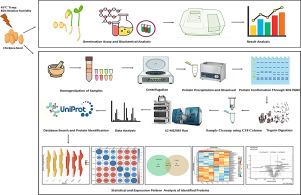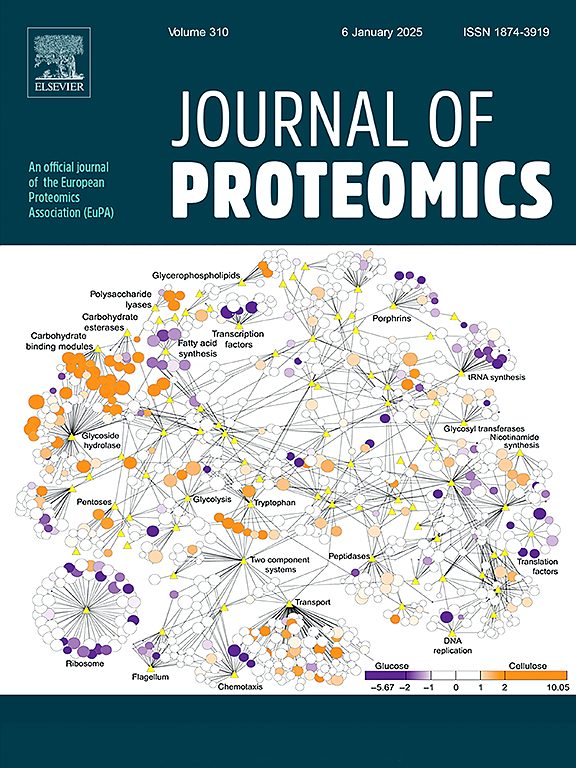老化条件下鹰嘴豆种子的综合蛋白质组学和代谢组学分析。
IF 2.8
2区 生物学
Q2 BIOCHEMICAL RESEARCH METHODS
引用次数: 0
摘要
鹰嘴豆种子在储存过程中的老化突出了重要的经济和农业问题。本研究将鹰嘴豆种子在45 °C、85 %湿度条件下老化4 天,影响了种子的活力和活力。对比生化分析表明,老化种子中活性氧的产生和膜损伤较高。采用Easy-nLC LC-MS/MS和GC-MS技术对种子进行比较蛋白质组学和代谢组学分析。在对照和老化种子之间鉴定出2605个蛋白质、17654个多肽和68个代谢物。共鉴定出118个具有统计学意义的蛋白质,其中98个蛋白质在老化处理中表现出不同的丰度。硅功能和亚细胞分析表明,这些蛋白质和代谢物与发芽、干燥耐受性、植物激素、脂肪酸、氨基酸代谢、碳同化途径有关,并在细胞内表现出多个位置。采用qRT-PCR方法验证8个选择基因的相对表达量,并与蛋白质组学结果进行对比。温度诱导脂钙蛋白(CaTIL)是一种保护蛋白,可以稳定膜并提供抗老化能力,并被选择用于分子表征。发现CaTIL的亚细胞定位在洋葱细胞的质膜上。本文章由计算机程序翻译,如有差异,请以英文原文为准。

Integrated proteomics and metabolomics analysis of chickpea seeds under aging condition
Seed aging in chickpeas during storage highlights significant economic and agricultural concerns. In this study, chickpea seeds were aged at 45 °C and 85 % humidity for 4 days, which affected both seeds' viability and vigor. Comparative biochemical analyses showed a higher production of ROS and membrane damage in the aged seeds. Comparative proteomics and metabolomics analyses of seeds were conducted using Easy-nLC LC-MS/MS and GC–MS techniques. This examination identified 2605 proteins, 17654 peptides, and 68 metabolites between the control and aged seeds. A total of 118 statistically significant proteins were identified, with 98 proteins exhibiting differential abundance in response to the aging treatment. The in-silico functional and subcellular analysis revealed that these proteins and metabolites are related to germination, desiccation tolerance, phytohormones, fatty acid, amino acid metabolism, carbon assimilation pathways, and exhibited several locations inside the cell.
The relative expression of 8 selected genes was verified using qRT-PCR to check the pattern with proteomics results. Temperature-induced lipocalin (CaTIL) is a protective protein that stabilizes the membrane and provides tolerance to aging, and was selected for molecular characterization. The subcellular localization of CaTIL was found to be in the plasma membrane of the onion cells.
求助全文
通过发布文献求助,成功后即可免费获取论文全文。
去求助
来源期刊

Journal of proteomics
生物-生化研究方法
CiteScore
7.10
自引率
3.00%
发文量
227
审稿时长
73 days
期刊介绍:
Journal of Proteomics is aimed at protein scientists and analytical chemists in the field of proteomics, biomarker discovery, protein analytics, plant proteomics, microbial and animal proteomics, human studies, tissue imaging by mass spectrometry, non-conventional and non-model organism proteomics, and protein bioinformatics. The journal welcomes papers in new and upcoming areas such as metabolomics, genomics, systems biology, toxicogenomics, pharmacoproteomics.
Journal of Proteomics unifies both fundamental scientists and clinicians, and includes translational research. Suggestions for reviews, webinars and thematic issues are welcome.
 求助内容:
求助内容: 应助结果提醒方式:
应助结果提醒方式:


